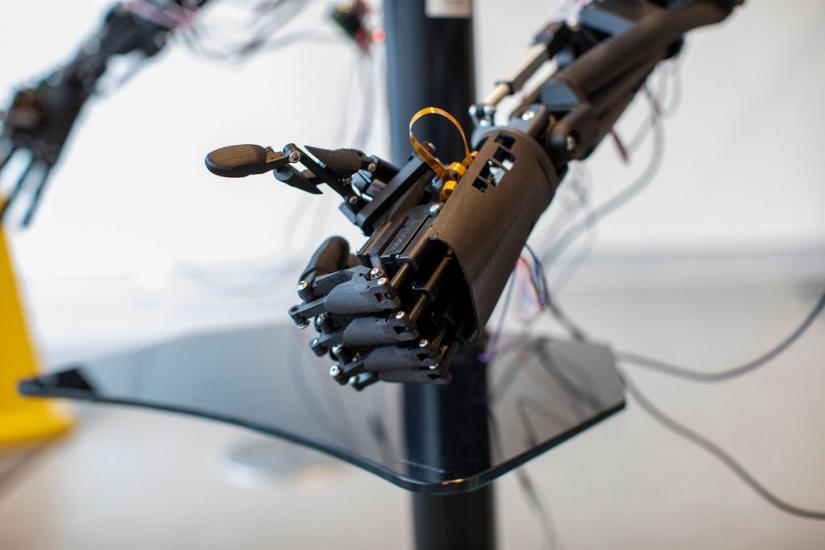AI-Exoskeleton: transforming rehab through robotics
AI-Exoskeleton, a breakthrough robot-assisted upper limb rehabilitation system, could make the path to recovery after stroke smoother for hundreds of thousands of stroke survivors in Australia.

Smoothing the path to recovery
Nicknamed 'Franky', after a cyborg in the popular anime "One Piece", the prototype was developed by HDR students from the School of Biomedical Engineering at UTS: Kairui Guo, Palayil Baby Jephil and Li Wang, under the supervision of Dr Steven Su, Associate Professor in the Faculty of Engineering and IT.
Franky's exoskeleton is made of 171 carbon-reinforced pieces printed at UTS ProtoSpace, combined with a host of robotic parts and sensors connected to a user-friendly touchscreen interface with wireless internet capabilities.
We designed Franky to be light and solid for people to use easily.
Kairui Guo,
CTO of AI-Exoskeleton
"Everything is aligned with human biomechanics so people can relearn the motor skills they lost through stroke by doing guided rehabilitation exercises."
Physical therapy guided by biosignals and machine learning
During the early stage of stroke recovery therapy, Franky reads the patient's desired movements by measuring their brain's electrical signals. It then gives direct visual feedback by robotically demonstrating the correct way to perform those movements. This visual training is designed to help the patient re-connect the damaged neural pathways.
Next, when patients regain some limb movement, Franky can be worn as an exoskeleton that provides physical assistance-as-needed to guide them through therapeutic movements.
"We're using an industrial level communication interface that can receive around 100 different inputs and process them with machine learning," explains Guo. "So that means you can have a lot of sensors on the human and the robot can process the signals simultaneously to help the patient with their physical therapy."
Thanks to its portability and machine-learning-aided session programming, the AI-Exoskeleton can deliver sophisticated and personalised training for stroke survivors in situ, without rehabilitation experts such as doctors needing to be physically present for every session.
As healthcare professionals can monitor physiological data and control the exoskeleton remotely through a web interface, the system could feasibly be employed for in-home therapy:
Telehealth and home-based therapies are not only convenient, they're also essential for many people who can't easily travel.
Kairui Guo,
CTO of AI-Exoskeleton
"Before COVID-19, it was already extremely hard for many patients to travel between their homes and rehab clinics. During the pandemic, it became even harder, so there's a huge need to make in-home rehab viable." explains Guo.
From Techcelerator to international collaboration
The AI-Exoskeleton's ability to support movement during rehabilitation therapy was successfully exhibited in December 2020 at the Techcelerator demo day hosted by the UTS Faculty of Engineering and IT, and won the Most technically Feasible Prototype Award.
The 'Franky' prototype has already attracted attention from healthcare institutes and hospitals in Australia, China and India interested in collaborating on clinical trials, which Guo says will likely span four years.
"Jephil, Li and I have had a lot of support at UTS to build Franky, and we get a lot of encouragement and feedback from everyone involved in the Techcelerator," says Guo. "We've learned so many things about commercialisation, such as customer validation, the business side of developing partnerships and even marketing – it's such a good learning process and it's really fun expanding our knowledge."
